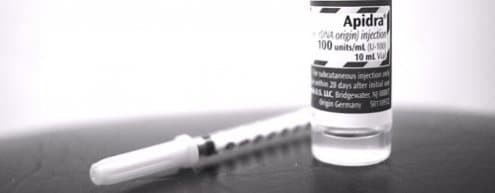What is Apidra (insulin glulisine) used for?
Apidra is fast-acting insulin (containing insulin glulisine) that is used with diet and exercise to control high blood glucose in people with diabetes. That means when you inject insulin glulisine, it starts to take effect quickly and lasts for a short while. Insulin glulisine is a man made insulin with the same properties as the insulin we produce naturally. Insulin helps our blood cells absorb glucose from the bloodstream so that it it can use it for energy. In addition, insulin helps our body to store extra glucose so that it can be used in future to produce energy.
However, the effect of insulin glulisine is usually shorter compared to the natural insulin produced by the pancreas in our body. You can use apidra to treat diabetes so that you can prevent the risk of having severe problems like heart attack or stroke. Do not use this medicine if you are allergic to insulin glulisine. This medication is not supposed to be used by children below the age of 4 years.
How to take insulin glulisine
Apidra is commonly taken through injection under the skin. Your doctor will show you how to take this insulin drug at home. You can use it in different places on your body such as under the skin of your stomach, upper arm or thigh. Before injecting the site, clean it with rubbing alcohol. Do not inject the same spot twice. Instead, change the injection site so that you can reduce the risk of developing lipodystrophy. You should never share an injection pen with any person even if the needle has been changed. Doing so could increase the risk of spreading infection such as HIV. If you are using an insulin pump to take this medication, you should not dilute it or mix it with another insulin. Insulin glulisine is supposed to have a clear appearance. In case it is discolored or has particles you should not use the insulin. You are supposed to change insulin glulisine inside the pump after 48 hours. Make sure you carefully follow the meal plan that was to be taken with this medication. It will ensure you achieve the best results out of this insulin treatment. Also make sure you engage in regular physical activity.
Dosage
The dosing for insulin glulisine will vary depending on the patient condition. This medication is usually injected within 15 minutes before you take a meal or within 20 minutes after you eat. Use this medication as it was prescribed by your doctor. This medication is supposed to be injected under the skin, preferably in the abdomen. Do not use apidra if you are not sure how to use it.
To prevent the risk of hypoglycemia, you should not inject insulin glulisine into the muscle or vein. You should not change your dosage without your doctor’s advice. In case of a drug overdose, you should contact your doctor immediately. People who overdose experience symptoms such as fast heartbeat, sweating, shakiness or loss of consciousness. If you missed a dose, you should not take a double injection to make up for the missed dose. You can take the missed dose anytime you remember. After taking the missed dose, you are supposed to take a meal after 15 minutes.
Storage
Insulin glulisine is supposed to be stored in the refrigerator, but not in a freezer. You can also store apidra under room temperature in a cool, dry place, that is away from moisture. Any insulin that is frozen should be thrown away. Ask your health care provider how you are supposed to properly dispose the medication. Make sure the medication is kept from the reach of children.
—
Disclaimer: Please note that the contents of this community article are strictly for informational purposes and should not be considered as medical advice. This article, and other community articles, are not written or reviewed for medical validity by Canadian Insulin or its staff. All views and opinions expressed by the contributing authors are not endorsed by Canadian Insulin. Always consult a medical professional for medical advice, diagnosis, and treatment.


